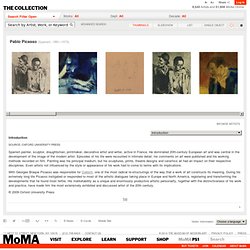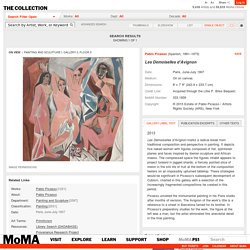

Pablo Picasso (Spanish, 1881–1973) Spanish painter, sculptor, draughtsman, printmaker, decorative artist and writer, active in France.

He dominated 20th-century European art and was central in the development of the image of the modern artist. Episodes of his life were recounted in intimate detail, his comments on art were published and his working methods recorded on film. Painting was his principal medium, but his sculptures, prints, theatre designs and ceramics all had an impact on their respective disciplines. Even artists not influenced by the style or appearance of his work had to come to terms with its implications.
With Georges Braque Picasso was responsible for Cubism, one of the most radical re-structurings of the way that a work of art constructs its meaning. . © 2009 Oxford University Press. Pablo Picasso. Arguably the most famous artist of the 20th century, Picasso was born in Spain, at Málaga, and received encouragement from his father, who was an artist and teacher.

Detail from Werner Bokelberg, Portrait of Picasso 1965© Photo courtesy of the owner After a period in Barcelona he moved to Paris in 1904. The early paintings of his so called blue period changed to paintings in tones of pink and grey. His interest in primitive art culminated in the painting 'The Demoiselles d'Avignon' (1906/7, Museum of Modern Art, New York). Semi-abstract painting in the form of 'Analytical Cubism' was developed by Picasso and Braque in the years 1910-12, followed by the less severe works of 'Synthetic Cubism' including 'Fruit Dish, Bottle and Violin' in 1912-16. Classical art became an increasingly important influence on Picasso's art following a visit to Rome in 1917. Pablo Picasso. Les Demoiselles d'Avignon. Paris, June-July 1907. Publication Excerpt: The Museum of Modern Art, MoMA Highlights, New York: The Museum of Modern Art, revised 2004, originally published 1999, p. 64 Les Demoiselles d'Avignon is one of the most important works in the genesis of modern art.

The painting depicts five naked prostitutes in a brothel; two of them push aside curtains around the space where the other women strike seductive and erotic poses—but their figures are composed of flat, splintered planes rather than rounded volumes, their eyes are lopsided or staring or asymmetrical, and the two women at the right have threatening masks for heads. The space, too, which should recede, comes forward in jagged shards, like broken glass.
In the still life at the bottom, a piece of melon slices the air like a scythe. The faces of the figures at the right are influenced by African masks, which Picasso assumed had functioned as magical protectors against dangerous spirits: this work, he said later, was his "first exorcism painting. " Picasso. Fernand Léger: The Bargeman (1999.363.35) Fernand leger. Jean Metzinger: Table by a Window (59.86) Jean metzinger. Diego Rivera: Table on a Cafe Terrace (49.70.51) Diego rivera. Juan Gris: Violin and Playing Cards (1996.403.14) Juan gris. Georges Braque: Still Life with a Pair of Banderillas (1999.363.11) Braque, Georges. George braque. Georges Braque. Roger de La Fresnaye: Artillery (1991.397) Roger de la fresnave.